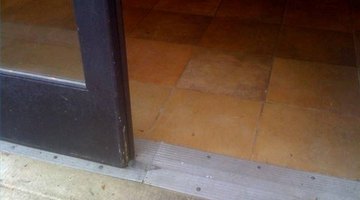About Thresholds
Table of Contents
Thresholds--sometimes called sills--are part of the weatherization and sealing system for door openings. They are generally made of metal or wood, and are installed on the floor underneath of a door to keep the opening weather-tight.

When used on the interior of the home, they act as a transition between rooms or different kinds of floor coverings. Thresholds are relatively affordable and easy to install, and are an important part of the door hardware package.
Function
The main function of the threshold is to close the gap between the bottom of a door and the floor, keeping air, rain and snow from getting into the home. This device works in conjunction with door bottoms and weatherstripping to seal the opening and protect the home from weather, insects and other pests. When combined with door bottom seals, a threshold is also an effective tool in preventing sound transmission or smoke infiltration from one room to another.
Benefits
Thresholds act to help seal the door. During the winter, they keep cold air out of the home while keeping expensive heat inside. In the summer, they keep conditioned air inside while keeping hot weather out. This not only helps to regulate utility bills, but also prevents energy from being wasted. Installing a threshold is a simple, low-tech, affordable way to be green and conserve resources. Aesthetically, they can help smooth out transitions between different types of flooring. For instance, in cases where carpet and tile meet in a doorway between two rooms, a threshold can improve the appearance of the joint where these materials meet.
Features
These devices are commonly made from aluminum, brass or wood, and are purchased in lengths that match the door opening. Because most doors are either 3', 3'-6", or 4' wide, these are the most common widths for thresholds as well. For doors of another size, the material can be cut in the field, or can be ordered to a custom size. The surface of the threshold is grooved, which acts to provide traction as well as to help prevent dirt and debris from being tracked into the home. Some thresholds come with built-in door seals or weatherstripping made from vinyl or neoprene to provide a total door seal system.
Types
There are three basic types of thresholds. The most common type is called a saddle, and can be used with any type of door. It is shaped like a shallow letter "U," which is placed upside down, like a riding saddle, over the bottom of the door opening. The second most common type of threshold is the panic variety. They are used on doors that are equipped with vertical rod exit devices, and feature a built-in strike for the bottom rod of the device. For doors that require a tight seal, interlocking thresholds are used. They feature a "J" shaped hook that locks into a similar hook installed on the door. This type of threshold provides a water-tight opening, but can become damaged if debris becomes trapped in the hooks.
Considerations
When it comes to choosing a threshold, it is important to balance weatherizing properties with accessibility and safety. In buildings that are open to the public, thresholds can be no higher than 1/2" at interior doors and 3/4" at exterior openings. In addition, the slope of the threshold can be no greater than 1:2. This helps ensure that people using wheelchairs can safely enter and exit the doors. These rules are set in place by the Americans With Disabilities Act, or ADA, and apply to all commercial construction. Even in buildings not subject to ADA, such as private residences, installers may want to consider using shallower, flatter thresholds with little or no slope because of the potential trip hazard.
Writer Bio
Emily Beach works in the commercial construction industry in Maryland. She received her LEED accreditation from the U.S. Green Building Council in 2008 and is in the process of working towards an Architectural Hardware Consultant certification from the Door and Hardware Institute. She received a bachelor's degree in economics and management from Goucher College in Towson, Maryland.
Photo Credits
- Bambi Turner
- Bambi Turner
More Articles



